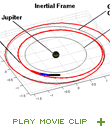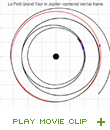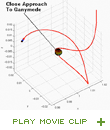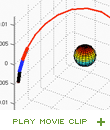Multi-Moon Orbiters of Jupiter's Icy Moon
There has been much recent interest in sending a spacecraft to perform extended observations of several of Jupiter's moons. Europa is thought to be a place hospitable to life because of the vast, liquid oceans that may exist under its icy crust. Two other Jupiter moons, Ganymede and Callisto, are now also thought to have liquid water beneath their surfaces. A proposed mission to Europa, and perhaps also Ganymede and Callisto, would attempt to map these regions of liquid water for follow-on missions.
A "Petit Grand Tour" of the Jupiter moon system is shown in the animations. This is an example of a multi-moon orbiter mission in which a single scientific spacecraft orbits several moons of Jupiter (or any of the outer planets' moons). Using this approach, long duration observations are possible instead of flybys lasting only seconds. A multi-moon orbiter could orbit each of the planet-sized moons of Jupiter--Callisto, Ganymede, Europa, and Io--one after the other, using a technologically feasible amount of fuel.
 |
 |
 |
 |
 |
 |
 |
| Petit Grand Tour trajectory |
 |
Petit Grand Tour trajectory seen projected onto the
orbital plane of Europa
and Ganymede |
 |
Ganymede loop-de-loop |
 |
Europa orbit insertion |
|



